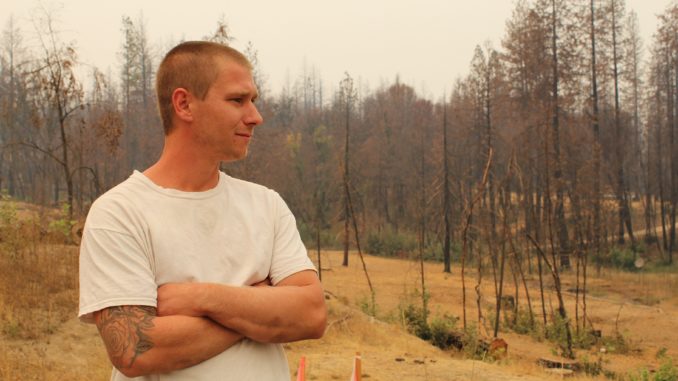
This feature is part of special wildfire report on the one-year anniversary of the North Complex Fire’s destruction of Berry Creek and Feather Falls. Find links for more articles in this series at the end of this story.
On the day the North Complex Fire barreled into Berry Creek, Josh Phillips’ phone lit up with an emergency alert sent out by the Butte County Sheriff’s Office. The first thing he did was drive to his grandfather’s house.
He shudders to think of what might have happened had he been out of town. By that point, the complex of lightning-ignited wildfires (primarily the Claremont and Bear fires) had been burning nearby in Plumas National Forest for nearly a month. His grandfather was asleep and hadn’t received the evacuation order.
“I went there and he didn’t even know,” Phillips said. “I got him outta there.”
Phillips told the CN&R that he thinks his grandfather could have easily died on Sept. 8, 2020, the day the wildfire rushed into the county, killing 16 foothill residents—14 in Berry Creek and two in nearby Feather Falls—and he believes that public safety agencies and PG&E hold a share of the blame.
A complex set of circumstances led to the tragic outcome that day. Like Phillips’ grandfather, other residents of Berry Creek did not receive an alert, according to numerous interviews conducted by the CN&R. Some had no cellphone, television or internet access because of a PG&E power-safety outage. Additionally, public safety personnel issued no warning ahead of an evacuation order for several towns, including Berry Creek, and had difficultly alerting those in the furthermost reaches.
Leading up to the anniversary of the disaster, the CN&R spoke with Butte County Sheriff-Coroner Kory Honea, Cal Fire personnel and others about what went wrong with the evacuation, the tragic outcome of the blaze, and what the agencies are working on to improve emergency response and communication in a region now facing potential mass casualty wildfire events on an annual basis. What they made clear is that the ways public safety departments historically have dealt with wildfire are not sufficient to deal with today’s megablazes.
Land of megafires
Back in 2018, it seemed like the Camp Fire was “a once in a lifetime thing,” Honea said. Until that point, the 2008 Butte Lightning Complex was the largest fire he’d witnessed in his decades-long career in local law enforcement. That series of blazes leveled the small community of Concow and injured nearly 80 people.
“Now they seem to be occurring on a regular basis,” Honea said.
Indeed, Butte County has experienced three megafires since 2018—two resulting in catastrophic loss of life. The 2018 Camp Fire and the 2020 North Complex Fire together killed 101 residents. The fires are the deadliest and fifth deadliest wildfires in state history, respectively, arguably making Butte County the megafire epicenter of the West. The Dixie Fire, the second largest wildfire in state history at 807,000 acres burned (as of press deadline), ignited near the Butte and Plumas county border and is still tearing through Northern California.
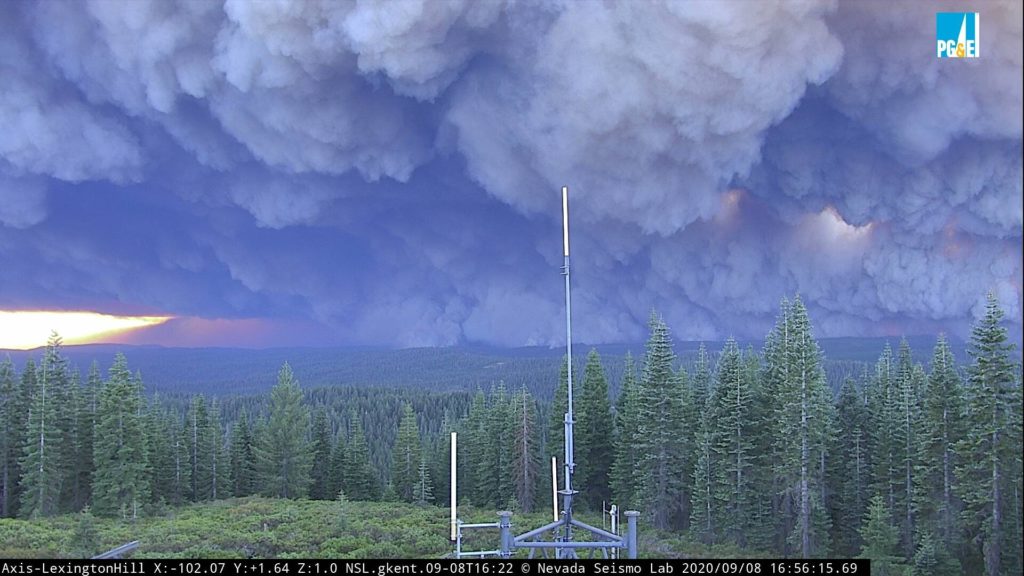
Garrett Sjolund, assistant chief for the Cal Fire Butte unit’s north operations, said that fire personnel have to be progressive in their approach to these new massive wildfires. Over his 25-year career with the agency, he’s noticed an evolution in tactical planning. Predicting fire behavior and its path of travel about a mile out used to be the standard. Now, in order to be prepared, professionals have to make such predictions 10-20 miles out because these fires burn so rapidly.
Though the North Complex Fire had been burning for weeks, the blaze became incredibly fast moving the day it made its run toward Berry Creek. The high winds that pushed it toward Berry Creek also grounded U.S. Forest Service planes, according to a video update shared on social media that day by the Plumas National Forest. In fact, Sjolund said that Cal Fire had to send out battalion chiefs to identify where the fire was in relation to Butte County, because it was progressing through areas outside their jurisdiction that were unstaffed.
That morning, Sjolund was the incident commander of a contingency team tasked with preparing a response plan if the fire entered Butte County. His team received a notification from Plumas National Forest representatives at 9:30 a.m. that the fire had escaped its containment line. At that point, however, it was still way outside of Butte County. For most of the day, predictions indicated the fire was headed toward La Porte, in Plumas County.
“This fire was in Quincy, 23 air miles away. It wasn’t anywhere near Butte County. There was no immediate threat up until the point we started receiving calls that we needed to pay attention [from Plumas National Forest],” Sjolund said.
At noon, Cal Fire’s Butte unit posted on social media that fire was not burning in Butte County, and the sheriff’s office shared the post on its platform. While that info technically was true, just a few hours later the sheriff’s office sent out an evacuation order, having issued no warning ahead of time to the foothill communities of Berry Creek, Brush Creek and Forbestown (only Clipper Mills and Feather Falls received a warning prior to an evacuation order).
Sjolund said his team did not receive notification from the Plumas National Forest, the lead agency on the North Complex Fire, that the fire was coming toward Butte County until 2:30 p.m. The official evacuation order from the sheriff’s office went out about an hour later.
Dazed and confused
Kyle Bisping, a fire survivor who now lives in Magalia, said the series of communications was confusing. For those who didn’t continually check for updates, the message that the fire was not in Butte County may have given a false impression that the region was safe.
The fire didn’t arrive in Butte County until around 8:30 p.m., but many were still caught unawares.
Berry Creek resident Ray Bartley and his wife, Teanea, were woken up at 11 p.m. by a firefighter friend banging on their door. Their power had been out due to PG&E’s public safety power shutoff, so they had no television or internet.
Bartley said his wife charged her phone with their generator, but they received no notice of the evacuation order earlier that day. They turned to social media to try to figure out what was going on “because we didn’t know,” Bartley said. That’s where they read in a foothills-area Facebook group that there was no fire in Butte County.
That night, they had just enough time to grab some of their animals and flee. Like all of the residents the CN&R spoke with, the Bartleys lost their home.
“If he wouldn’t have come to our house, we probably would have been running out of the house with the back of it on fire … with just the shirts on our backs,” he said.
Erik House experienced a similar abrupt awakening—a sheriff’s deputy pounding on the door and telling his family to get out. Like the Bartleys, his power had been shut off. His phone was barely charged, but he never got an emergency notification, he said. He’d been checking his wind-up radio for any evacuation news and hadn’t received any.
On getting out of Berry Creek: “It was hell,” he said. “It was such a rush that even my grandma’s ashes got left in the fire.”
Bisping doesn’t mince words when talking about his views on the job that emergency responders did during the fire: “Those we count on to protect us let us down.”
“There are a lot of people that do not have cellphones and the power was off, so there were many, many people that got no word of warning,” he said.
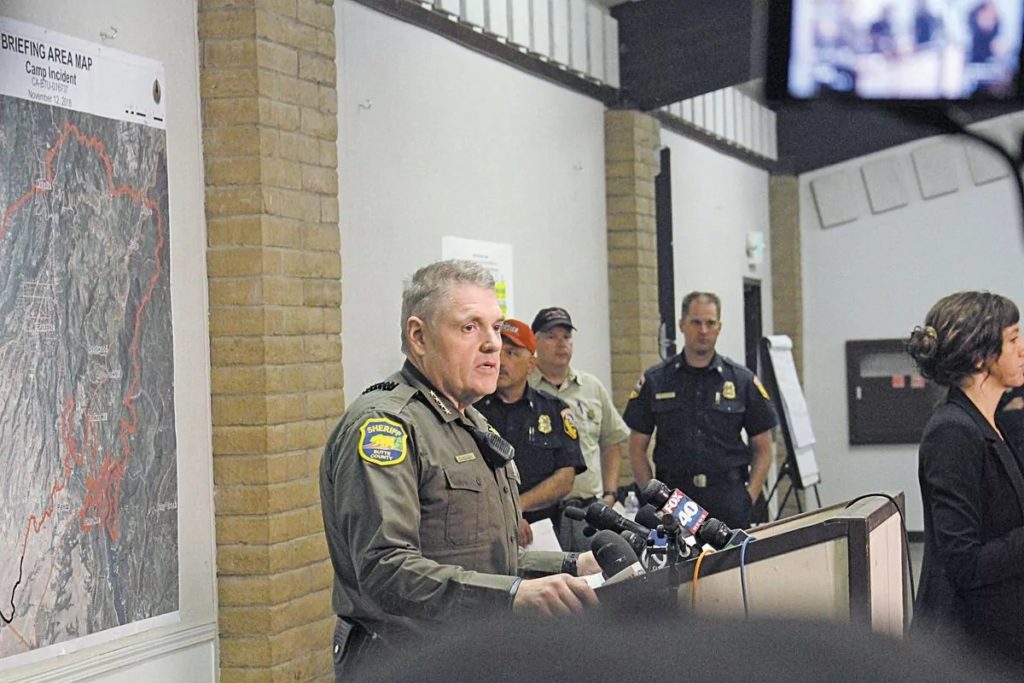
Though the Butte County Sheriff’s Office equipped every patrol vehicle with high-low evacuation sirens in July 2019, none of the residents the CN&R spoke with heard them during the North Complex Fire.
Honea said that deputies used them, but he acknowledged that they couldn’t get through more remote parts of the foothills due to the rough terrain.
“It was not for a lack of real effort on our part to get that message out,” he said. “There is no way to guarantee 100 percent saturation of your message, especially in remote, difficult-to-reach localities. That’s why we have tried really to develop as robust a system as possible.”
Honea acknowledged other communication issues that transpired that day. He told the CN&R he found out about the danger to Butte County after receiving a call from the Plumas County sheriff, who’d attended a briefing with the Plumas County incident management team, which did not have a BCSO representative. Honea said he immediately alerted his team, which worked in conjunction with Cal Fire to communicate evacuation information to the public as quickly as possible.
“Our position is that the [Plumas] incident management team should have been keeping us better apprised of what was going on,” he said. “That was one of the frustrations we had. … We don’t feel they provided us with timely info.”
Honea has since worked to improve inter-county communications by including a representative from his department as part of the incident command team of fires in neighboring counties, starting with the Dixie Fire. That representative is still working with the team today, even though the fire is no longer active in Butte County.
“We’re continuing to embed personnel, so I can be assured that we’re getting info that we need in a timely fashion should the situation change and a threat to Butte County arrives again,” he said.
The CN&R reached out to Plumas National Forest representatives, who did not respond to questions as of press deadline. A video update posted to the agency’s Facebook page at 3:44 p.m. on Sept. 8 detailed how rapidly the North Complex Fire exploded that day, at a rate of 1,000 acres every 30 minutes. (Sjolund told the CN&R this “was astronomical” and “off the charts.”) It grounded aircraft and made it challenging for USFS to get data on the fire. A representative projected that the North Complex Fire would reach Oroville and urged everyone to check their county’s evacuation information and follow those orders to leave.
As for PG&E, company spokesman Paul Moreno told the CN&R that the utility’s power-safety shutoffs are triggered by low humidity, wind and fuel conditions, and other fire risk factors. He said that PG&E notifies customers multiple times before the power is shut off and also alerts emergency responders in advance.
“We do meet with and hear from agencies to get feedback on the PSPS [Public Safety Power Shutoff] program and to help us identify ways we can improve the program,” he said via email. “We also urge customers to be prepared for PSPS events and other power outages by charging cell phones and devices, having a battery or crank radio, and to have an emergency plan.”
Life-saving improvements
Sjolund said the magnitude of the loss of life in the Camp Fire wasn’t ignored after that massive blaze, pointing to changes made as a result.
Cal Fire set up a triage unit at its Berry Creek station during the North Complex Fire, he said, noting that Highway 162, a major evacuation route, was cut off by the blaze. Firefighters brought imperiled residents to this refuge point, Sjolund said, and treated more than 20 for second- and third-degree burns.
“That was something very significant on the incident that saved lives,” he said.
Cal Fire has made additional operational improvements since the North Complex Fire, too. This summer, incident commanders received a technology upgrade that allows them to examine current weather and fuel types to create wildfire models, Sjolund said. This new tech was used extensively during the Dixie Fire.
They deployed drones with infrared technology that examine fire lines to provide real-time information to firefighters on the ground, he said. In addition, they installed mobile communication devices on their pickups that allow them to receive satellite communications.
Sjolund said these changes are, in part, why the Dixie Fire hasn’t been as devastating for Butte County.
“It is very fresh in our memories on what worked and what hasn’t worked in the last four years,” he said. “I think it could have been a lot worse.”
Meanwhile, earlier this year, Honea was contacted by Global Security Systems, a company that specializes in emergency alert technology. The company recommended a program called ALERT FM, which is used by emergency personnel to send alerts, such as evacuation orders, via satellite to FM radio stations and on to battery-powered receivers in people’s homes. The devices display messages and emit a bright, flashing light and a high-low siren sound.
In May, the Butte County Board of Supervisors voted unanimously to spend $500,000 from its Camp Fire settlement with PG&E to pay for the system’s satellite services, licensing, installation, operation and warranty for five years. Shortly after, PG&E committed $100,000 to subsidize the cost of receivers for citizens in remote parts of the county.
Honea said he intends to get ALERT FM off the ground as soon as possible. The sheriff’s office anticipates easily integrating the technology with its current emergency notification system, CodeRED (which sends out alerts via landline, cellphone text and email), with all of the alerts sent out at the same time.
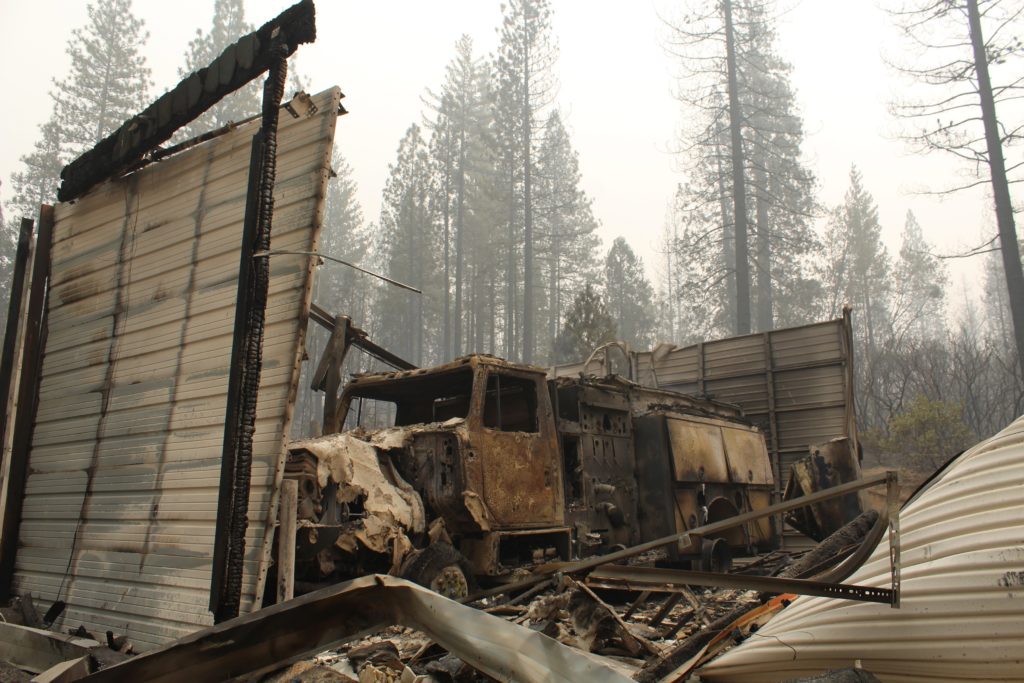
“There’s no one perfect solution to this very complex problem,” Honea said. “We have to have multiple platforms, multiple tools.”
Other emergency evacuation improvements are underway as well. Notably, the sheriff’s office is working with Cal Fire and other Butte County departments, including the Office of Emergency Services, to create evacuation zone maps.
Three years ago, when the Camp Fire struck, Butte County had no public facing evacuation map, according to BCSO spokeswoman Megan McMann. The zones are intended to make it much clearer for residents when disaster strikes—all they need to know is which zone they inhabit.
Butte County tentatively plans to release the zones to the public next year, McMann said.
All of these improvements are part of the county’s evolving understanding of the way fires develop, Honea said.
Engaged and alert
Phillips has chosen to stay in Berry Creek, but his grandfather, who is in his 70s, and mother have since relocated to the Bay Area. Though his grandpa is a “mountain man,” it’s not practical for him to live in such a rough, remote area, given the dangers, he said.
When it comes to the evacuation improvements that are underway at the county, Phillips said he supports “any step to help us … one million percent.”
However, he’s still uneasy about the future. He worries that the county will have a hard time reaching secluded residents who live off-the-grid, he said. One of his friends was killed by the blaze.
“These are some of the best people I’ve ever met in my life,” he said. “I just feel like we were kicked to the curb at the end of the day, and those are lives people are playing with.”
Honea stressed the importance of community members staying engaged and alert. The sheriff’s office conducted interviews with the family, neighbors and friends of those who perished during the North Complex Fire. Some knew the fire was coming but chose to stay, he said.
Residents living in wildfire-prone areas need to create defensible space, be ready to go and heed evacuation orders “to prevent those kind of tragedies from occurring in the future,” Honea said.
“It is certainly my hope and desire that we never lose another person to these fires,” he said. “And that is one of the reasons that we continually look at ways that we can enhance and develop and improve our ability to alert and warn people.”
Further reading:
“Sparking debate”
“Our wildfire breaking point”
“Accountability”


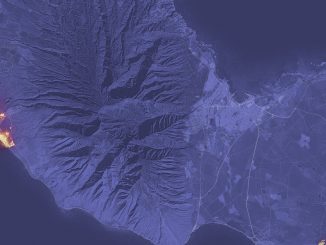

Be the first to comment